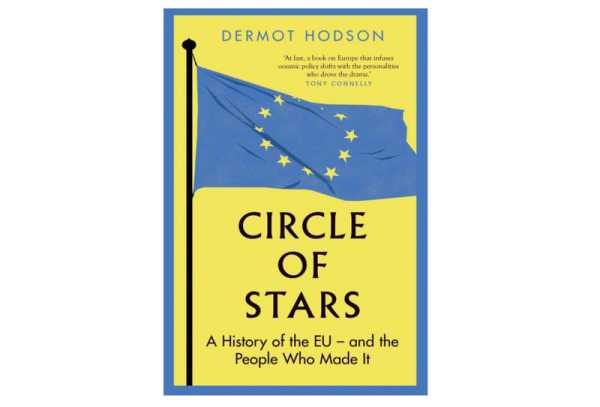
Hodson makes it very clear in this readable book (with real people in it) that it is the member states who have most of the power in Brussels — and increasingly so
Most books about Europe written by academics are unreadable for the wider public. They tend to be full of jargon and focus on tired, academic pet subjects like the ‘democratic deficit’.
Just once in a while, a book comes along that zooms out instead of in, avoiding acronyms and actually trying to answer the main question many citizens have had for a long time: who has the power in Europe? Who takes the decisions in Brussels?
-

de Gruyter: 'Circle of Stars helps the bigger public to understand why we live in a different Europe than just a few years ago'
Such a ‘macro book’ is Circle of Stars; A History of the EU and the People Who Made It (Yale University Press) by Dermot Hodson, professor of political economy and digital technologies at Loughborough University in London and a visiting professor at the College of Europe in Bruges.
Hodson, who has previously worked for the European Commission, makes it very clear in this readable book (with real people in it) that it is the member states who have most of the power in Brussels — and increasingly so.
This is because, contrary to the false popular narrative, member states have never yielded major national powers to the European Commission, except in the fields of agriculture, trade and a few others.
Instead, they have pooled some national powers with each other, and have received collective sovereignty in exchange for it. This process has accelerated since the Maastricht Treaty in 1992 because, as Alan Milward already argued in his formidable book The European Rescue of the Nation-State in 1992, national leaders have discovered that thanks to the EU they are more powerful than they would have been without the EU.
Hodson writes: “National leaders stuck with the EU after Maastricht not because they shared an ideological commitment to an ever closer union but because they believed that their countries could manage global crises more effectively by working together.”
For many reasons, right after the fall of the Berlin Wall and the disintegration of the Soviet Union, national leaders decided on new, ambitious projects in areas hitherto national: the euro; Schengen and more cooperation on justice and home affairs; and foreign and security policy.
These areas were highly sensitive in many member states. Therefore, the leaders did not give the European Commission far-reaching decision-making powers, but instead kept control over these areas themselves by requiring unanimity — meaning all national capitals must agree on any decision and have a veto on almost everything.
In the past couple of years, this tendency has become even stronger as member states faced problems they could not possibly solve alone, such as climate change and the rise of powerful digital multinationals such as Google, Microsoft and Amazon.
At the same time, a series of mostly external shocks rocked the EU’s foundations: the financial crisis and euro crisis, the refugee crisis, terrorist attacks, the pandemic and Russia’s invasion of Ukraine all forced national leaders to pool resources and powers.
Because of all those pressures, the heads of state and government were faced with a stark choice each time: either let the EU fall apart, or Europeanise highly sensitive areas like health, security and defence, too.
Sign up for EUobserver’s daily newsletter
All the stories we publish, sent at 7.30 AM.
By signing up, you agree to our Terms of Use and Privacy Policy.
The fact that they chose the latter is significant. There is only one explanation: they did not want the EU to fall apart.
This increased Europeanisation came at a price, though: more power for national leaders in Brussels. From European vaccines to the €800bn recovery program after the pandemic and immigration policies, leaders are more firmly behind the wheel in Brussels than ever before.
While previously, they had taken all important decisions in Europe and then stepping back to let the European Commission manage the implementation of those decisions, nowadays they do not step back anymore and stay involved with the implementation, too.
For example, national representatives co-decide with the commission on each other’s national projects getting recovery funds instead of leaving this to Commission experts; they meticulously screen (and sometimes alter) the commission’s draft contracts for vaccines; and also co-sign agreements with third countries on migration, such as the (already botched) one with Tunisia in 2023.
Unfortunately, national leaders keep their electorates in the dark about their growing responsibilities in Brussels.
They keep lashing out at supposedly all-powerful ‘eurocrats’, denying their own, growing power in Europe. Clearly, they prefer citizens to believe the old story of a monstrous Brussels bureaucracy acting by itself at the detriment of member states — even though today, this is less true than ever before. Hodson touches on this, but he could have been much stronger on this point.
Circle of Stars helps the bigger public to understand why we live in a different Europe than just a few years ago. In the past, the narrative often was that the more powerful the Commission became, the less power was left for member states and vice versa. This does not hold any longer. Today, both the Commission and the member states are increasing their powers in tandem. If only the public knew this.
Circle of Stars; A History of the EU and the People Who Made It by Dermot Hodson, Yale University Press (2023)
Source: euobserver.com



